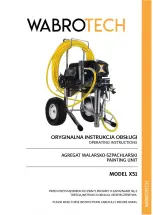
3
310799B
COBALT HVLP SIPHON/PRESSURE FEED SPRAY GUN
Setup
•
Check that your shop air provides adequate air flow.
•
Use a minimum 3/8 in. ID air supply hose.
•
Set shop air pressure regulator (not supplied) according to
paint manufacturer’s recommendation for. See maximum
pressures and compliant air pressures on cover.
•
Make sure no air restrictions, such as low-volume cheater-
valves, obstruct the air flow. If an air adjusting valve is
desired, use a SHARPE Air Adjusting Valve 24AAV (part
no. 2210), 36AAV-HOV (part no. 3310) or HOV (part no.
U04410).
•
Install a shutoff valve (not supplied) downstream of the air
regulator to shut off gun air.
•
Install an inline air filter (not supplied) to clean and dry the
air supply to the gun.
1.
Shut off air supply.
2.
Connect a clean, dry, filtered air supply to the gun air inlet
(9). See F
IG
. 1, page 4.
3.
If this is first time using the equipment, flush the spray gun.
Operation
Pressure Relief Procedure
1.
Turn off gun air supply.
2.
Trigger the gun to relieve pressure.
Flushing
Flush before using the equipment, before changing colors, and
when you are done spraying. Use solvent that is compatible with
gun wetted parts and fluid that will be sprayed. Flush at lowest
possible pressure.
1.
Follow
Pressure Relief Procedure
.
2.
Dispose of any paint in cup.
3.
Fill cup with small amount of solvent.
4.
Spray into grounded metal waste container until equipment
is clean.
5.
Follow
Pressure Relief Procedure
.
Spraying
1.
Fill cup with material and connect to gun fluid inlet (37) or
connect fluid supply hose if pressure feeding gun. See F
IG
.
1, page 4.
2.
Turn on shop air to gun and set atomizing pressure with the
gun fully triggered.
3.
Adjust the pattern size and shape with the spray width
adjustment knob (17). Turn knob clockwise to reduce pattern
size and counterclockwise to increase it.
4.
Fluid control knob (15) is factory set for maximum needle
trigger travel and material flow. To decrease needle/trigger
travel and decrease fluid flow, turn the knob clockwise.
WARNING
Follow
Pressure Relief Procedure
when you stop spraying
and before cleaning, checking, or servicing equipment. Read
warnings, page 2.
WARNING
Read warnings, page 2.
Refer to
Compliant Cleaning Methods
, page 4, to com-
ply with air quality laws if applicable.
CAUTION
Excessive atomizing air pressure can increase over-spray,
reduce transfer efficiency, result in a poor quality finish
from dry spray.
Regulatory agencies in certain states prohibit the operation
of a spray gun above 10 psi (69 kPa, .7 bar) atomizing air
cap pressure.
See
Troubleshooting
guide if you experience an irregular
pattern.
























